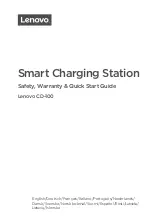
5. SPECIFICATIONS
6. SAFETY
The charger should only be used to charge the battery and to start a car engine, not for other purposes.
The service must be performed only by trained and experienced persons. It is not intended for use by
persons (including children) with reduced physical, sensory, mental capabilities or lack of experience or
knowledge, since it could put your health at risk.
- Children should be supervised in order to avoid playing with the device.
Safety requirements
Never replace the fuses to repair. Mechanical damage to the cable insulation wire output terminals is not
permitted, as well as getting the chemically active media (acids, oils, gasoline, etc.). Charge the battery in
a well ventilated areas.
Prevention of electric shock and burns.
- All wiring must comply with regulations and standards and instructions to prevent injuries.
- Ensure the implementation and the charger is properly grounded.
- Do not charge in an environment of high humidity or rain.
- Do not use damaged or worn cables. Always check the terminals, chargers and power cables and make
sure the insulation is not damaged.
- Do not use the charger or power supply cables, with little cross section.
- If the cables are overheated, stop charging to prevent rapid deterioration of the insulation.
- Never touch any part of the power supply circuit. After use, carefully remove the terminal and allow con-
tact with earthed parts.
- Do not perform repairs or maintenance when the battery charger is on.
- The chargers should be checked and maintained by qualified personnel.
To prevent the combustion gases during charging of batteries.
- Do not charge in a place where there is suspicion of leaking natural gas and other explosive gases; or
load near flammable materials or liquids.
- Do not charge near the baths used for the extraction of oils used with other agents combustion.
Waste.
- The boots are made of materials that do not contain toxic or harmful substances.
- Before being dismissed, the charger must be analyzed and its components must be separated accor-
ding to the type of construction material.
Input voltaje
Frequency
Power
Load voltaje
Battery capacity
Current charge
Dimensions
Weight
DAMAX - 15
DAMAX - 30
50 Hz
700 W
12/24 V
120 - 160 Ah
20 A
290*275*225 mm
9.2 kg
220V 10%
50 Hz
150 W
12/24 V
35 - 105 Ah/ 12 v 20 - 60 Ah / 24 v
7.5 / 5.0 A
250*210*215 mm
4.8 kg
220V 10%
+-
7






























